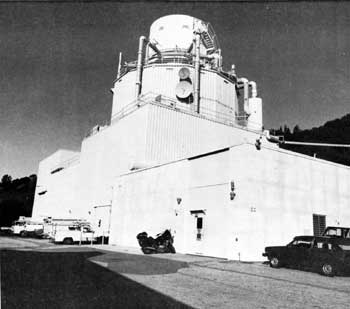.gif)
|
Man in Space
A National Historic Landmark Theme Study |

|
|
Unmanned Spacecraft Test Facilities |

Exterior View of Twenty-Five-Foot Space Simulator, 1983.
(Courtesy of NASA-JPL, JPL Facilities Office)
Twenty-Five-Foot Space Simulator
| Name: | Twenty-Five-Foot Space Simulator |
| Location: | Jet Propulsion Laboratory, Pasadena, California |
| Owner: | National Aeronautics and Space Administration (NASA) |
| Condition: | Excellent, original site |
| Builder/Architect: | NASA |
| Dates: | 1961-Present |
DESCRIPTION
The 25-foot Space. Simulator is at the Jet Propulsion Laboratory (JPL) in Pasadena, California. It was built in 1961 to provide high-quality space simulation for testing spacecraft under conditions of extreme cold, high vacuum, and intense, highly uniform collimated solar radiation. [1]
The 25-foot Space Simulator chamber is a stainless-steel cylindrical vessel 27 feet in diameter and 85 feet high; a 15-by 25-foot side-opening access door is provided for test-item loading. A personnel door provides entry through the access door. The minimum operating pressure of the chamber is 5 x 10-7 torr. The walls and floor are lined with thermally opaque aluminum cryogenic shrouds controlled over a temperature range of -320° to +200°F by liquid or gaseous nitrogen. The off-axis solar simulation system consists of an array of 37 xenon 20- to 30-kilowatt compact arc lamps, an integrating lens unit, a penetration window, and a one-piece collimator. This provides a simulated solar beam that is reflected down into the test volume by the collimating mirror, which is temperature controlled with gaseous nitrogen through a range of -100° to +200°F
The test volume of the Simulator, 20 feet in diameter and 25 feet high, can be irradiated by a beam pf simulated solar energy selected from a variety of beam sizes and intensities. The maximum beam diameter is 18.5 feet, which can provide intensities up to 2.7 solar constants. With a smaller collimating mirror and different integrating lens unit, a 9-foot diameter beam with intensities up to 12 solar constants can be provided. The spectrum is that of xenon arc lamps, as modified by the simulator optics. A water-cooled douser is provided to simulate eclipse of the sun.
The simulated space environment can be established in about 75 minutes. Test conditions can be terminated and access provided to the test item in about 2-1/2 hours.
A 1000-square-foot clean room facility is available for test article assembly and system test prior to environmental testing. An airlock separates the clean room from the Simulator.
Test article (spacecraft) suspension within the Space Simulator can be provided by a variety of support systems. The chamber has wall-mounted attachment points at three levels, each capable of a 10,000-pound vertical load. These points can be used to attach suspension cables or fixed hardware.
The cooled chamber floor has openings that allow support columns for hardmounted support structure. These columns rest on an isolated seismic mass below the Simulator.
A geosynchronous orbit simulation support system is available, providing one revolution per day with a fast advance and return capability and declination angle change, all possible in a vacuum.
Special test article loading provisions can be accommodated, using either a movable monorail hoist or ramp system within the chamber.
The 25-Foot Space Simulator is still in use by NASA and is likely to remain in use for many years to come.
STATEMENT OF SIGNIFICANCE
The 25-Foot Space Simulator has technological capabilities in simulating the environment of space and has strong associations with the unmanned space exploration program of the United States.
The 25-Foot Space Simulator is the only NASA facility capable of producing true interplanetary conditions of extreme cold, high vacuum, and intense solar radiation coupled with a 25 foot-test chamber that can accommodate most modern spacecraft. Its use of a collimating mirror to produce the intense solar radiation of space was the first system of its type when installed in 1966.
This ability to create a true space environment has led engineers and scientists from Europe and Japan to study its many support systems in an attempt to build similar facilities in those countries.
Over the years spacecraft tested in this facility include Ranger, Surveyor, Mariner, Voyager and other spacecraft. The success of the American space program in exploring these planets has not been replicated by any other nation. One of the reasons for this success is the 25-Foot Space Simulator that enables JPL engineers to test their spacecraft in a true space environment and to locate and eliminate any problems before launch.
FOOTNOTES
1. The descriptive material from this section has been taken from the following source. Our Captive Space--JPL Space Simulator Facilities (Pasadena, California: Jet Propulsion Laboratory, 1980). pp. 2-5.
BIBLIOGRAPHY
Blaine, J.C.D. The End of an Era in Space Exploration. San Diego, California: American Astronautical Society, 1976.
Koppes, Clayton, R. JPL and the American Space Program. New Haven: Yale University Press, 1982.
Our Captive Space-JPL Space Simulator Facilities. Pasadena, California: Jet Propulsion Laboratory, 1980.
Technical Facilities Catalog Vol. I. Washington, D.C.: National Aeronautics and Space Administration, 1974.
PHOTOGRAPHS
(click on the above photographs for a more detailed view)
Last Modified: Mon, Jan 8 2001 10:00:00 am PDT
man-in-space/space20.htm



 Top
Top